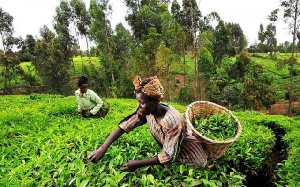According to the Food and Agricultural Organization of the United Nations Ghana in the last decade has made a concerted effort to increase and improve staple crop production largely carried out by smallholder farmers. The country’s effort rests largely on development aid from Western countries, particularly from Bill and Melinda Gates-funded Alliance for Green Revolution in Africa (AGRA). In mainstream discourse, the Green Revolution is portrayed as an initiative helping to improve the livelihoods of smallholder farmers including doubling their income, reducing food insecurity, as well as ensuring sustainable and climate-friendly green agriculture. Probably you have heard the term "Green Revolution" many times. What does it actually mean? Let’s search for the answer.
Throughout history, farmers have been looking for ways to increase their production. Using indigenous knowledge, farmers did simple plant breeding by selecting the best seeds from their produce for reproduction. They also relied on open pollination technique as well as using organic manure to increase yield and fertility of the soil. As society progressed, this knowledge was refined leading to new discoveries of farming technologies.
It was after World War II that farming technology took a complete new trajectory. According to food system expert Professor Philip H. Howard of Michigan State University, the knowledge of making explosives and other warfare chemicals after the war was transferred to making fertilizer, agro chemicals, hybridized seeds among others to improve crop yield. This was the birth of the Green Revolution. These off-farm inputs hitherto not used in agriculture production were regarded as superior due to their ability to increase crop yield. The United States government, the United Nations, the Rockefeller Foundation and the Ford Foundation became the prime advocates for farming with these inputs. In a speech in 1968, the then administrator of the United states Agency for International Development William S. Gaud coined the term "Green Revolution" eulogizing the ‘success’ of the initiative to demonize the Soviet Union who had gone through a violent uprising (Red Revolution) beginning from the era of Vladimir Lenin and his Bolshevik cohorts. The idea behind the Green Revolution is that traditional method of farming is ‘irrational’ hence farmers should adopt modern method by embracing the inputs to improve production.
There are natural barriers in agriculture which prevented capital investment previously. For example, if you plant a crop today you have to wait for some time to harvest. Further, the amount of the harvest will depend on the weather, fertility of the soil among others. Admittedly, the application of inputs including pesticides, weedicides, fertilizers, high yielding short term seeds, Genetically Modified Organisms, controlled irrigations have broken the barriers. This has made agriculture attractive to capital.
In fact, studies show agribusiness corporations through merger and acquisitions are today the sole producers of these farming inputs. To add to the advantage of the corporations, application of the inputs is viewed by many national farm policymakers as ‘rational’ and ‘modern’ as it has the capacity to increase crop yield. This has made some farmers to believe that the ‘rational’ and ‘modern’ way to cultivate is to use off-farm inputs. By adopting this thinking, farmers are participating in the eradication of barriers in agriculture for capital accumulation. To explain how farmers participate in the process, Howard uses the concept of agriculture treadmills. The treadmills were first used by the American farm policy expert Willard Wesley Cochrane in 1958. Cochrane theorizes that since demand for agricultural products (food) is price inelastic, increased in production is likely to reduce price, disadvantaging farmers. His assumption is based on the economic principle that increase in supply more than demand leads to fall in price. For farmers even if increase in supply leads to fall in price, they would still want to increase production in order to maintain revenue. And to increase production, farmers will have to apply inputs.
To make it clearer, Howard divides the treadmills into three categories— pesticides, seed and fertilizers. There are natural predators to pest. But as farmers keep applying pesticides, these predators die off, and the pest with time also become resistant. This means farmers have to apply new and more pesticides. Like the pesticides, synthetic fertilizers also kill organic compounds in the soil. This leads to soil depletion and increasing need to apply more fertilizers. Seeds treadmill involves farmers constantly purchasing seeds from agribusiness corporations to reproduce. This eliminates seed savings practiced by farmers. The treadmills mean almost complete dependence of farmers on agribusiness corporations to produce and reproduce.
Over the years, successive Ghanaian governments have vigorously promoted the idea of improving small famers’ production through the use of off-farm inputs. A notable initiative is the periodic free fertilizers given to farmers to improve soil fertility. Apart from this, the country’s development partners including AGRA and other Western NGOs who are funded by agribusiness corporations have also been baiting smallholder farmers with inputs. These organizations orient farmers with the inputs by initially giving it out for free. As farmers become excited with the inputs due to increase in yield, they are then required to buy them. In their paper titled Potential Impacts of a Green Revolution in Africa—the Case of Ghana published in the Journal of international development Breisinger et.al affirm that improved seeds, fertilizers, pesticides and other agro-chemicals are the main drivers of the Green Revolution in Ghana. They add that the success of the Green Revolution in Ghana should be judged on the price affordability of these inputs for smallholder farmers. But are the inputs affordable and helping smallholder farmers to thrive? The evidence would answer.
A fieldwork conducted in the Eastern Region of Ghana in 2014 by Kiera Butler, senior editor of the American investigative news outlets Mother Jones reveals that a United States-based NGO named 4-H is training smallholder farmers especially the youth to use high-yielding hybrid seeds from agribusiness corporations for cultivation. Take note that 4-H solicits corporate donations from agribusiness giants including DuPont, Monsanto, and Cargill. Butler admits that the seeds have the capacity to increase production but they are super expensive and can’t be reproduced:
“Everyone was loving these seeds, the yields were better, they were doing better in dry weather; the problem was that they were like 10 times the price of the old seeds. Nobody could afford them. The idea was that once you get your yields up, you’ll make more money, and you’ll be able to buy the seeds. Now, the problem is that these are hybrid seeds. With obatanpa you can just collect seeds from the harvest — you don’t have to buy more. But these hybrid seeds, you can’t collect after harvest — they’ll just return to what’s called the parent generation without all the good characteristics”.
Apart from the seeds, Butler also sheds light on how the farmers are encouraged to use chemical fertilizers and pesticides. These inputs were initially provided free of charge by 4-H but was stopped as the program progressed. Clearly, from the account of Butler there is the conscious effort to have farmers abandoned their traditional seeds and become dependent on agribusiness-produced seeds and other inputs.
Scrutinizing the government of Ghana’s policy of teaming up with international donor agencies to encourage small farmers to enter into contract farming, the International Food Policy and Research Institute (IFPRI)-backed study illuminates the hidden appropriation involves in the program. According to the study conducted in Northern Region, the program provides fixed farming inputs including hybrid seed, fertilizer, and weedicides among others to farmers. After harvest, the produce is bought by the agencies and the cost of inputs deducted. In extensive interviews with some participants of the program, the IFPRI reveals the farmers were far better off using their traditional seeds and method of farming than the contract farming. The researchers find increase in production of the contract farming but after deductions of the cost of the inputs are made, farmers were left with income barely able to take care of their families. One striking thing the farmer's highlight is that they cannot go back to their traditional way of production as their lands have become accustomed to fertilizers and other agrochemicals. This means once farmers are hooked onto the inputs it becomes difficult to break away. It is almost the same as opium addiction.
In another study published in 2014 in the journal Food Policy by two academics Alejandro Nin-Pratt and Linden McBride Pratt titled Agricultural intensification in Ghana: Evaluating the optimist’s case for a Green Revolution, it finds yam, a staple crop hitherto cultivated by smallholder farmers in a traditional way is now increasingly becoming dependent on expensive fertilizers and seeds. The study shows farmers who continue to use the inputs become ultimately inefficient. Just like the IFPRI study, this also finds an increase in production for farmers who use the inputs but if the costs are deducted farmers are left with almost nothing, making their condition difficult than when they were using their traditional method to cultivate.
The empirical evidence, of course, appears to suggest farmers are being consciously made to get hook onto the inputs. However, it is worth noting that it is not the Ghanaian government per who is making the farmers to become dependent on the inputs. The finger hence can be pointed at the conditions attached to development aid it receives. Renowned rural sociologist, Professor Kojo Amanor of the University of Ghana confirms this by revealing that while giving development aid, AGRA has also been strategically promoting the development of agricultural input markets in Ghana [specifically targeting smallholder farmers]. Pounder on this popular adage: "There is no such thing as a free lunch".
Issaka Adams
The writer is a student at the International Institute of Social Studies of Erasmus University in The Hague, The Netherlands.
Email: 467377ia@eur.nl
Opinions of Saturday, 14 July 2018
Columnist: Adams Issaka



















